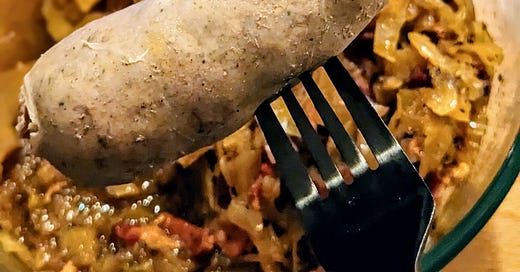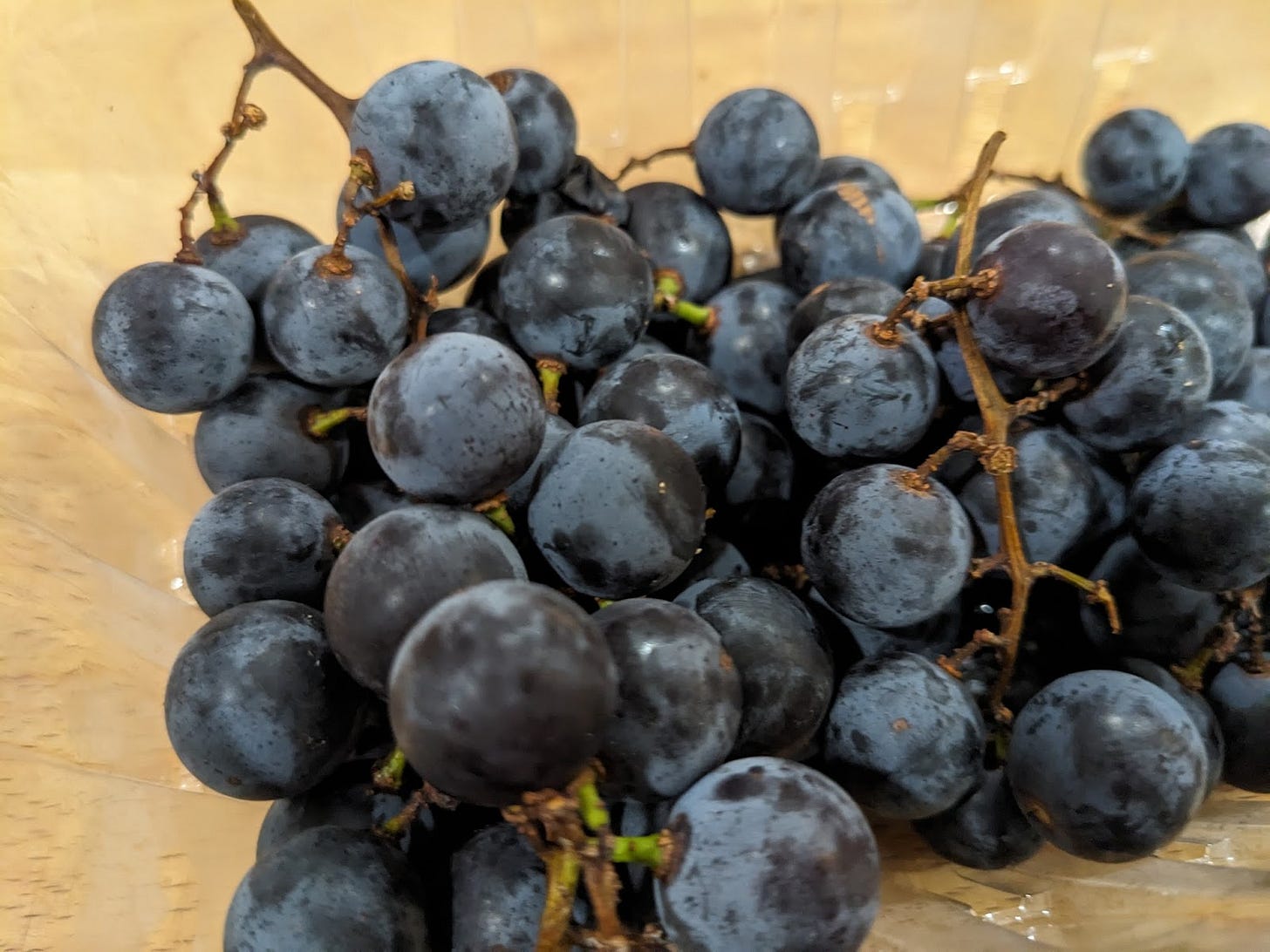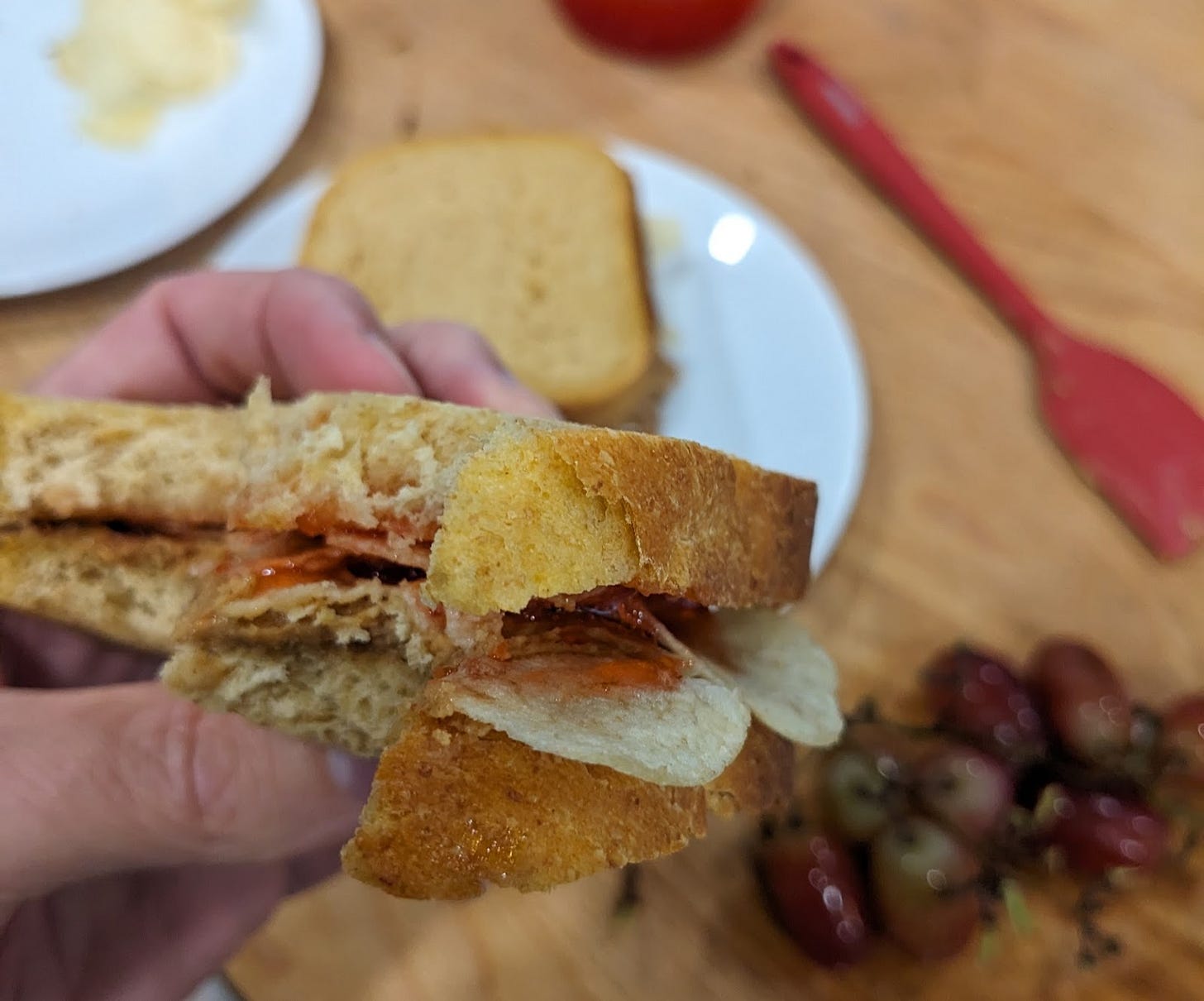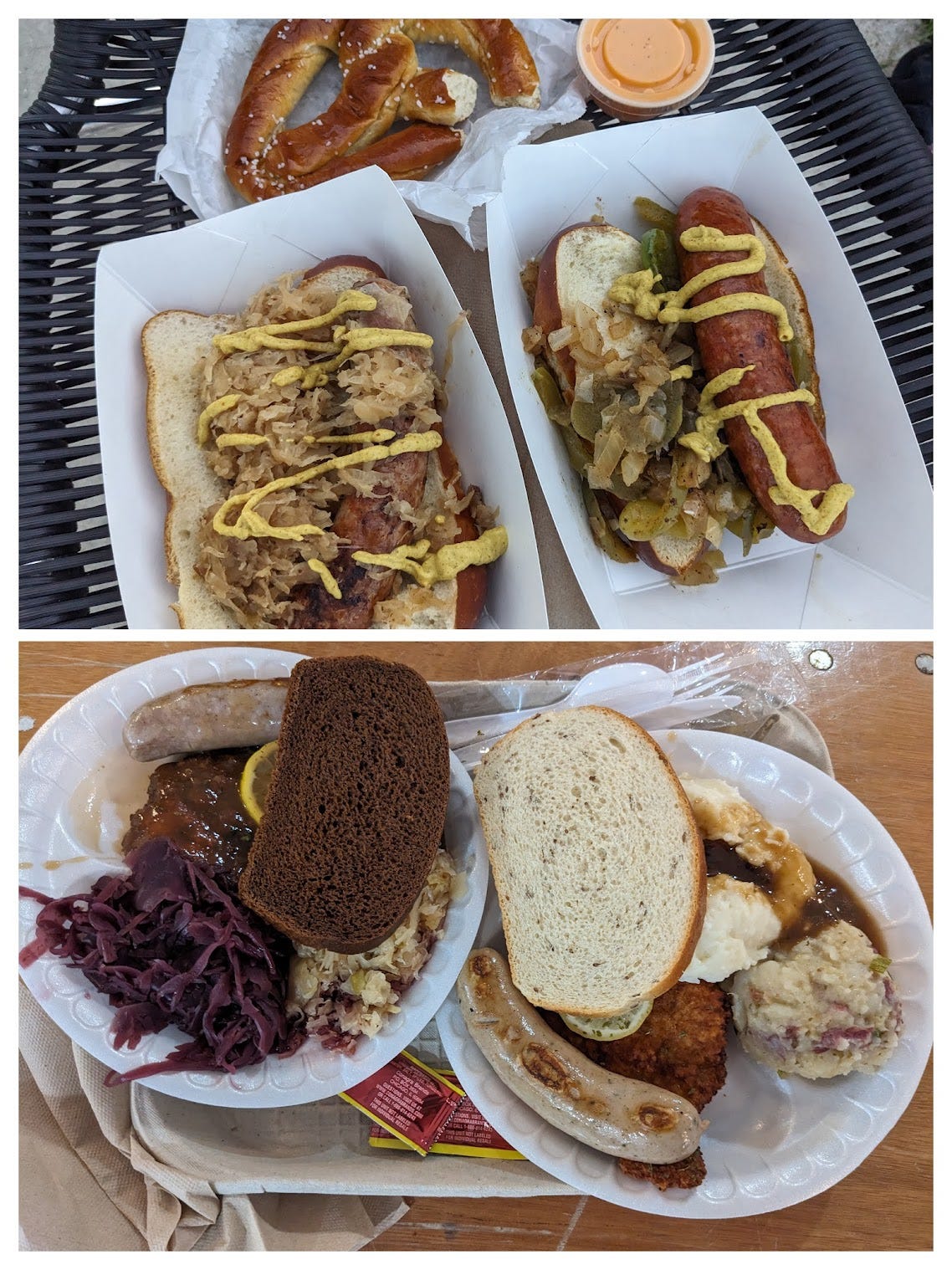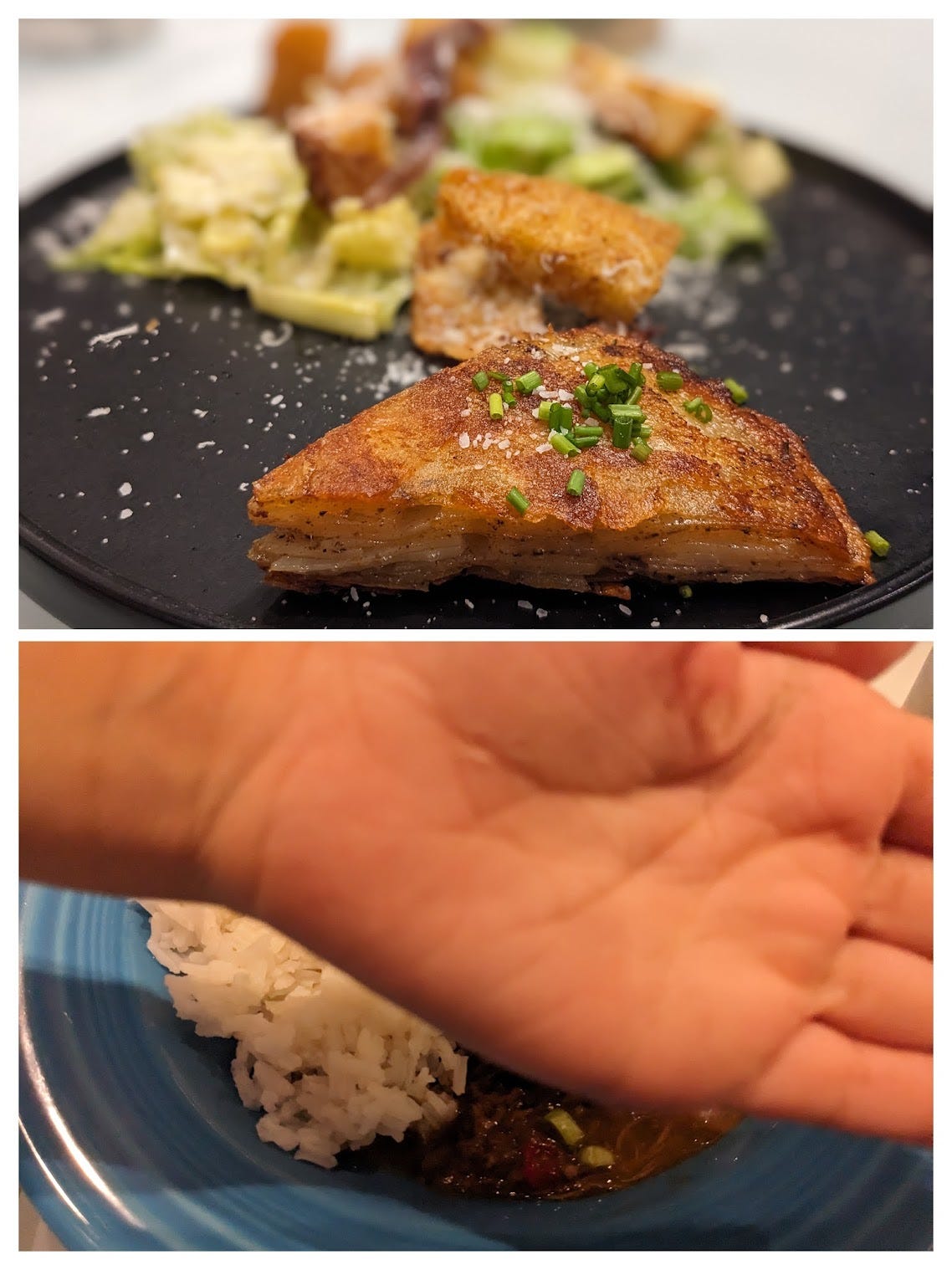Recipe: Kiełbasa Biała Surowa - White Sausage
Intro: Polish American Heritage Month - Week 3 of 5: Sausage for the Proletariat
Notable Foods I ate this week
Next Week’s Recipe: Pierogi
Kiełbasa Biała Surowa - White Sausage
I cannot believe that despite the pounds and pounds of sausage I made, stuffed, and cooked, this was the only picture I took.
This recipe calls for a lot of special equipment including grinders and sausage stuffers to make this beautiful fresh sausage. The grind size makes or breaks the sausage and the texture will not be right if you use anything smaller than a 10mm grinder plate for the pork - especially if using a worm style stuffer like that found on Kitchenaid mixer attachments. If using a press style of stuffer, you can go as low as 8mm, as the press will be faster and more gentle with the meat. If you do not have access to a 10mm grinding plate (which I did not) then a butcher will be able to grind the pork shoulder for you. When making the emulsion, it is important to maintain a temperature below 40 F to ensure safety and prevent bacterial growth. This also applies to grinding and stuffing. Keep the parts of the grinders and stuffers in the freezer until ready to use, and keep the meat refrigerated until ready to grind or stuff. You can place the meat in the freezer for up to an hour to lower the temperature, and you can also grind and stuff in batches to ensure the temperature stays low. I am a huge fan of garlic and this is my favorite part of the sausage. This recipe calls for 2 cloves, but I prefer 3 or 4. Adjust to your taste. The main spice that cannot be replaced or substituted is marjoram. The rest of the mix in this recipe is called ‘herbal pepper’ and is generally flexible. While traditionally stuffed in casing, you may skip the stuffing process and use the loose sausage by crumbling in a fry pan or mixing into soups/braises.
Ingredients (Makes about 5 lbs.)
1.8kg, or 4 Lbs. Pork Shoulder, Ground on a 10mm, or 3/8” plate
110g Ice Water
230g, or ½ Lbs Beef Sirloin, Ground, or finely cubed
105g Ice Cubes
Spice Mix:
2 cloves garlic
35g, or 2 Tbsp Kosher Salt
2g or 1 tsp Ground Black Pepper
4g or 2 tsp Ground or 6 tsp Crushed Marjoram
4g or 1 tsp Paprika
2 Large Bay leaves
2g or ½ tsp Ground Mustard Powder
2 g or ½ tsp Caraway seeds
35mm fresh Hog Casing, at least 3 meters (Optional)
Directions
In the bowl of a food processor, add all of the spices and garlic then pulse until fine. Add the ground sirloin and the ice then pulse until just combined, then process on high until a goopy, sticky, homogeneous paste is formed, about 20 - 30 seconds. Use caution when processing longer than this and check the temperature. It is important not to bring the mixture above 40 F to prevent bacterial growth.
In a large mixing bowl, stir and fold together the ground pork and the emulsified beef along with 110g ice water. Do not overmix. It is helpful to add the beef mixture in small portions to help mix evenly. Add the bowl to the fridge for at least 1 hour to firm up (20-30 minutes in the freezer).
If stuffing the sausage, clean and desalinate the casing by rinsing inside and out with water. Attach the casing to a sausage stuffing tube. Add the ground meat mixture to the stuffer and allow the meat to come out slightly before tying off the end of the casing. Stuff the sausage with all of the meat mixture, forming into a large coil, but do not overstuff. This will prevent breaking when forming links Tie off the ends, then twist into links, alternating direction for each link. Leave uncovered in the fridge for 4-12 hours to condition the casing before cooking.
Cook the kielbasa by boiling in water or by braising in soups such as zurek or with cabbage for at least 15 minutes, or grill the sausage for 7-12 minutes with low or indirect heat or until internal temperature reaches 165 F. Serve immediately.
Intro: Polish American Heritage Month - Week 3 of 5: Sausage for the Proletariat
The experience that I have with Polish food comes from my time living in Michigan, and it would not have been possible without the immigration of Polish families over the last 150 years. Over 750k Americans living in Michigan claim Polish Ancestry which is ranked third highest in population behind New York and Illinois.The First Major wave of Polish Immigration to the United States brought in thousands of families that settled in only a few major areas of the United States. Detroit was a major Metropolitan hub for Polish immigration. Around 1850, many families moved out of the Detroit area and formed their own farming communities, taking advantage of a Federal Law called the ‘Swamp Land Act of 1850” which entitled Americans to ownership of unusable lands if it was converted into productive agricultural use. One such community was Parisville, MI, which is recognized as one of the first Polish American communities. Over the next several decades, Polish Immigrants and Polish Amercans moved about the state of Michigan, forming similar communities. Polish migrants in the US mostly farmed and labored in mines. Chicago had the highest Polish population at the turn of the century, and the city being well known for meat processing saw Polish laborers dominate the industry. These jobs ranged from slaughter, to butchering, to grinding, to packing and shipping across the Midwest. Polish Americans and Migrants began making a positive impact in the laboring and entrepreneurial industries around the late 19th century, but unfortunately the Polish designation was tarnished by Leon Czolgosz, an American born man with Polish Ancestry from Alpena, MI that assassinated President William McKinnely. This unjustly caused mass profiling against Polish Americans and even directly led to the Immigration Act of 1903 which further regulated the admittance of immigrants into the United States, even though Czolgosz was not an immigrant. Perception of Polish Americans plummeted over the following decades, resulting in segregated Polish communities, and high unemployment rates and low incomes for those with Polish ancestry.
It was not until after WWII and the transition of Communism in Poland that the second wave of Polish Immigration to the United States brought tens of thousands of migrants displaced by the war. And with the mass immigration, it brought back some of the long overdue esteem to Polish American communities. It was during this time that the Polish Communist government was cut off from the rest of the Western world. Despite being ravaged by the war, the country received little support - The currency could not be converted and the government was barred from purchasing goods or obtaining loans from other countries. This forced the government to start selling raw or natural products such as coal, fruits, and of course - meat. In order to compete with other markets and to appease Western importers, the quality of Polish products needed to be high quality - beyond exceptional. As a direct result, the Department of Meat Industry was formed. It is said that because the meat industry now belonged to the state, the communist government officials spent most of their time eating sausages and became well aware of which formerly independent meat plants had the best recipes and the highest standards. At the time, sausage was regionally diverse, where some types of sausages only existed in small corners of the country, and even in those sausage niches, butchers, meat packers, and even families had their own “best” recipe. In 1958 the Department of Meat Industry collected ‘meat technologists’ and well educated experts in the meat industry and wrote a 300 page manual standardizing all Polish meat products. This covered all aspects of the industry from safety, butchering, aging, curing, cooking - and contained ingredients and instructions for making over 70 types of sausages in extensive detail. These manuals were distributed only to the meat plant managers and kept closely guarded from the public eye, and inspectors would meticulously inspect each meat plant to ensure the standards were followed to a ‘T’. Each plant manager had the guide to make the quality sausages that Poland quickly became known for. Aside from coal, meat became Poland’s largest export, and many years after, the Polish government would revise and publish new manuals on meat standardization. It has been said time and time again that despite the atrocities inflicted by the Polish government on its people during communism, this was the golden era for Polish sausage. Today, long after the fall of communism, the Polish government publishes standards for the meat industry, but is not enforced as strictly, and the exceptional quality seems to be a faint echo of such an auspicious tubed meat epoch.
It is no surprise that Polish Americans continued this tradition of quality meat production, even with looser regulations here in the United States than in Poland. Bobak’s in Chicago and Kowalski meats are long standing testaments to that. Even Smithfield, one of the largest US based meat packing companies has recently acquired 3 Polish based meat companies, upholding the idea that Polish meat is still of great quality and excels here in the US. For the most part, Americans will jump to smoked sausage when they think of kielbasa. In fact, kielbasa simply means ‘sausage’ in Polish, and can refer to well over a hundred different kinds of sausage in Poland. In the early 2000’s, Miroslaw Gebarowski started an online forum dedicated to the preservation of prime time Polish sausage recipes called: https://www.meatsandsausages.com/
It took off like wildfire in Poland, but it was not until later that Stanley Marianski, a Polish American living in the US built a relationship with Gebrowski and not only expanded the online recipe collection to contain many more Polish meat products besides sausage, but updated many of the recipes to include English translations. With this relationship, the two kielbasa connoisseurs wrote a book titled Polish Sausages:Authentic Recipes and Instructions. It was this book that created the foundation for this week’s recipe (and is an amazing resource for sausage making techniques in general). And, yes, Kiełbasa Biała Surowa is not a smoked sausage, nor is it cured or aged. It is a fresh sausage like bratwurst or Italian sausage.
White kielbasa may be one of my favorite types of sausage. It is quicker and simpler to make, as it does not involve strict ratios for curing salts, a long complicated aging process, or expensive smoking equipment. This fresh sausage has historically been less popular for manufactures because it has a very short shelf life. This means that it was typically made directly in people’s homes right before consumption. White sausage in Poland is also sometimes called ‘Easter Sausage’ because of its popularity around the Holiday, and is often served with ‘zurek’, a soup made from fermented rye, stock, and hearty root vegetables . Growing up in West Michigan with access to the best fresh kielbasa at Lewandowski's Market is something I took for granted before moving 1000 miles away. It was a staple at Bab's holiday gatherings - piping hot chunks of garlicky sausage mixed into a steaming bed of Sauerkraut turned into family fanfare. So traditional with her family in fact, that we served that very dish at our wedding. It seems to give the whole family gas and heartburn, though… Maybe some traditions are worth the suffering, and the urge for good sausage and great company is impossible to subdue.
What I ate this week:
Concord Grapes: Can’t tell you how excited I was to be able to find good grapes like this in the South.
Peanut Butter and Jelly with potato chips - I don't think I can ever grow out of this and frankly I don’t ever want to.
Oktoberfest Fare - Bab’s and I ran a 6k for some masochistic reason and it just happened to coincide with Oktoberfest. It was so easy to pack down German food after running - We had a pretzel with beer cheese, brat with kraut on a pretzel bun, Hungarian sausage with onions and peppers on pretzel bun, two plates of pork schnitzel, weisswurst, brat, red cabbage, kraut, mashed potatoes with mushroom gravy, german potato salad, and slices of rye bread. Everything was amazing, the sausages were a dream come true, and the schnitzel was crisp and tender… The pretzels were not nearly as good as mine, though.
Sausage Breakfast Sandwich - I took some of the loose kielbasa then added fennel and creole seasoning and slapped it on a bun with egg and cheese and later that night I literally had a dream that I won an award because it was so good.
Colin made Cesar Salad and Pommes Anna-ish at the request of the child, and said child apparently wanted the picture of Colin’s gumbo to be redacted from this week’s Substack. The pommes anna-ish is ‘ish’ because it is fried in butter on both sides, and is so crisp and buttery and delicious that you almost forget how to chew.
Upcoming Recipe: Pierogi
Pierogi: Perfectly palatable plump potato pockets

